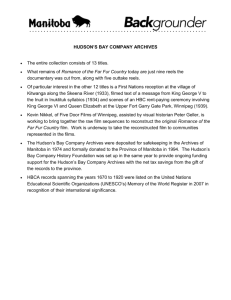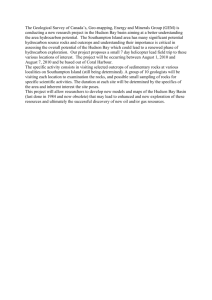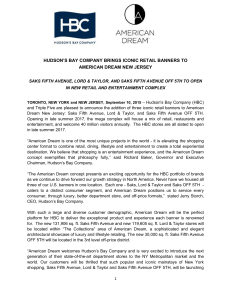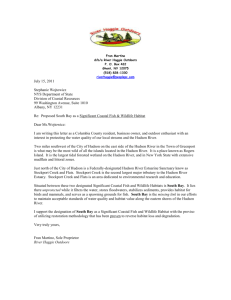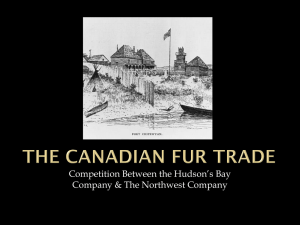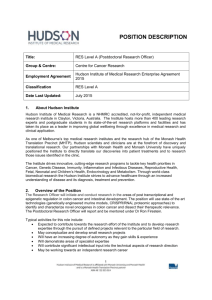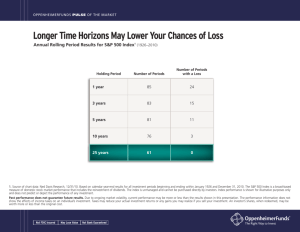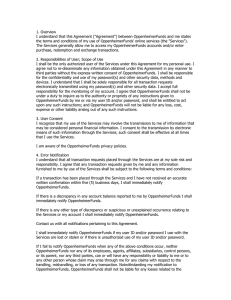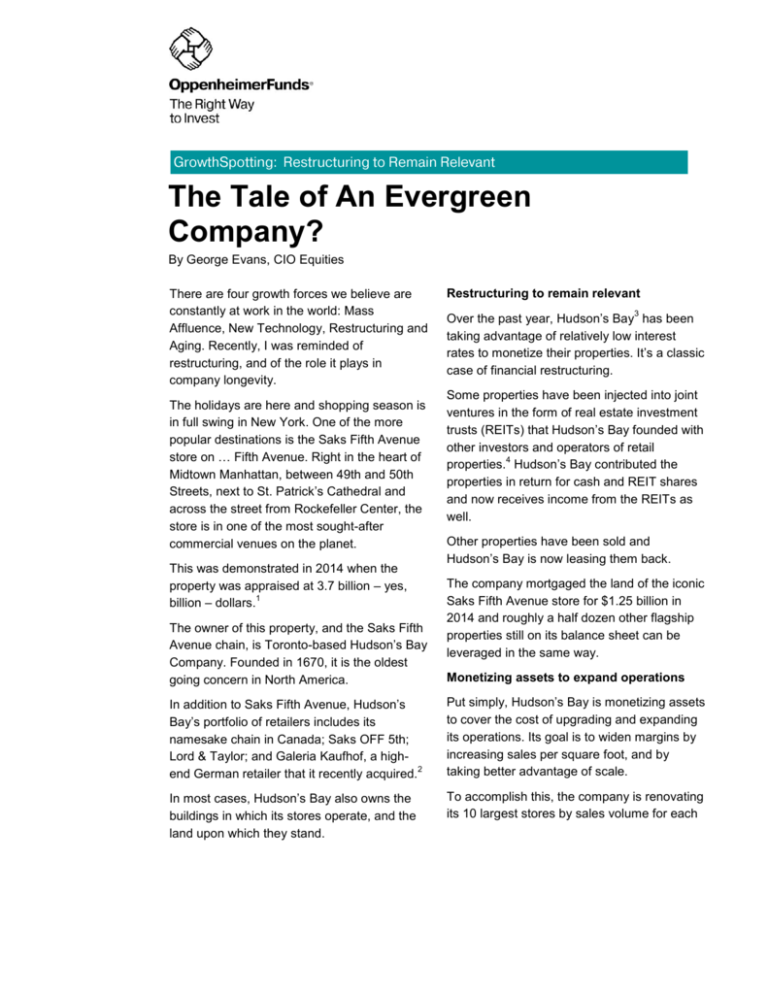
The Tale of An Evergreen
Company?
By George Evans, CIO Equities
There are four growth forces we believe are
constantly at work in the world: Mass
Affluence, New Technology, Restructuring and
Aging. Recently, I was reminded of
restructuring, and of the role it plays in
company longevity.
The holidays are here and shopping season is
in full swing in New York. One of the more
popular destinations is the Saks Fifth Avenue
store on … Fifth Avenue. Right in the heart of
Midtown Manhattan, between 49th and 50th
Streets, next to St. Patrick’s Cathedral and
across the street from Rockefeller Center, the
store is in one of the most sought-after
commercial venues on the planet.
This was demonstrated in 2014 when the
property was appraised at 3.7 billion – yes,
1
billion – dollars.
The owner of this property, and the Saks Fifth
Avenue chain, is Toronto-based Hudson’s Bay
Company. Founded in 1670, it is the oldest
going concern in North America.
Restructuring to remain relevant
3
Over the past year, Hudson’s Bay has been
taking advantage of relatively low interest
rates to monetize their properties. It’s a classic
case of financial restructuring.
Some properties have been injected into joint
ventures in the form of real estate investment
trusts (REITs) that Hudson’s Bay founded with
other investors and operators of retail
4
properties. Hudson’s Bay contributed the
properties in return for cash and REIT shares
and now receives income from the REITs as
well.
Other properties have been sold and
Hudson’s Bay is now leasing them back.
The company mortgaged the land of the iconic
Saks Fifth Avenue store for $1.25 billion in
2014 and roughly a half dozen other flagship
properties still on its balance sheet can be
leveraged in the same way.
Monetizing assets to expand operations
In addition to Saks Fifth Avenue, Hudson’s
Bay’s portfolio of retailers includes its
namesake chain in Canada; Saks OFF 5th;
Lord & Taylor; and Galeria Kaufhof, a high2
end German retailer that it recently acquired.
Put simply, Hudson’s Bay is monetizing assets
to cover the cost of upgrading and expanding
its operations. Its goal is to widen margins by
increasing sales per square foot, and by
taking better advantage of scale.
In most cases, Hudson’s Bay also owns the
buildings in which its stores operate, and the
land upon which they stand.
To accomplish this, the company is renovating
its 10 largest stores by sales volume for each
retail chain and investing in digital
infrastructure across its entire fleet of stores.
The strategy is to make shopping at key
stores like Saks Fifth Avenue an experience
that casts a halo effect, and encourages
shopping online and at other locations.
It remains to be seen whether this strategy will
succeed.
The point is that Hudson’s Bay began
operating trading posts in the 17th century,
and is still doing so today; they just look
different now.
Until now, Hudson’s Bay has been a classic
example of how companies must repeatedly
restructure and reinvent themselves to sustain
competitive advantages, retain relevance and
create wealth for investors if they are to be
long-lived.
Source: Bloomberg News
Wall Street Journal
3 Source: SEC N-Q Filing, 11/20/15. As of 8/31/15, the Oppenheimer International Growth Fund owned approximately 11.5 million
Hudson’s Bay Co. shares.
4 Source: Financial Post
5Source: Business Wire
1
2 Source:
These views represent the opinions of OppenheimerFunds and are not intended as investment advice or to predict or depict the performance of
any investment. These views are as of the publication date, and are subject to change based on subsequent developments.
Foreign investments may be volatile and involve additional expenses and special risks, including currency fluctuations, foreign taxes, regulatory and
geopolitical risks.
Shares of Oppenheimer funds are not deposits or obligations of any bank, are not guaranteed by any bank, are not insured by the FDIC or any other
agency, and involve investment risks, including the possible loss of the principal amount invested.
Before investing in any of the Oppenheimer funds, investors should carefully consider a fund’s investment
objectives, risks, charges and expenses. Fund prospectuses and summary prospectuses contain this and other
information about the funds, and may be obtained by asking your financial advisor, visiting
oppenheimerfunds.com or calling 1.800.CALL OPP (225.5677). Read prospectuses and summary prospectuses
carefully before investing.
Oppenheimer funds are distributed by OppenheimerFunds Distributor, Inc.
225 Liberty Street, New York, NY 10281-1008
© 2015 OppenheimerFunds Distributor, Inc. All rights reserved.
JPG0000.802.1215

